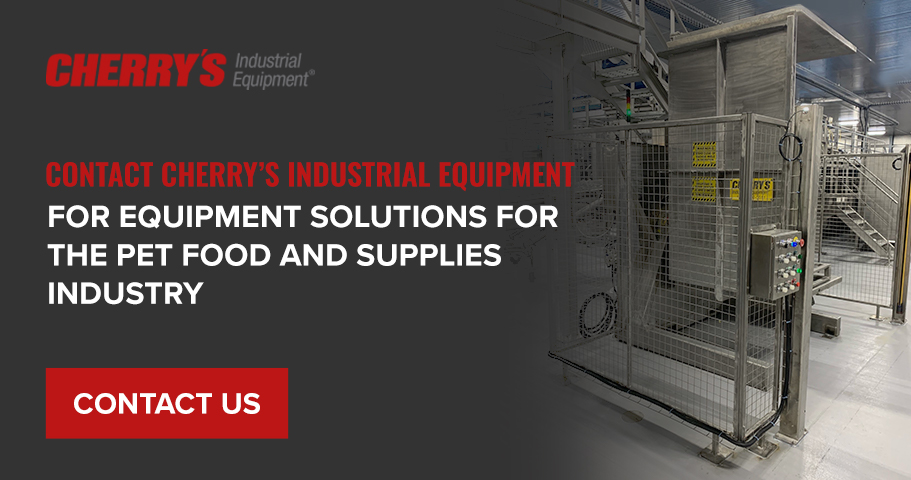Pet Food and Supplies Industry Solutions
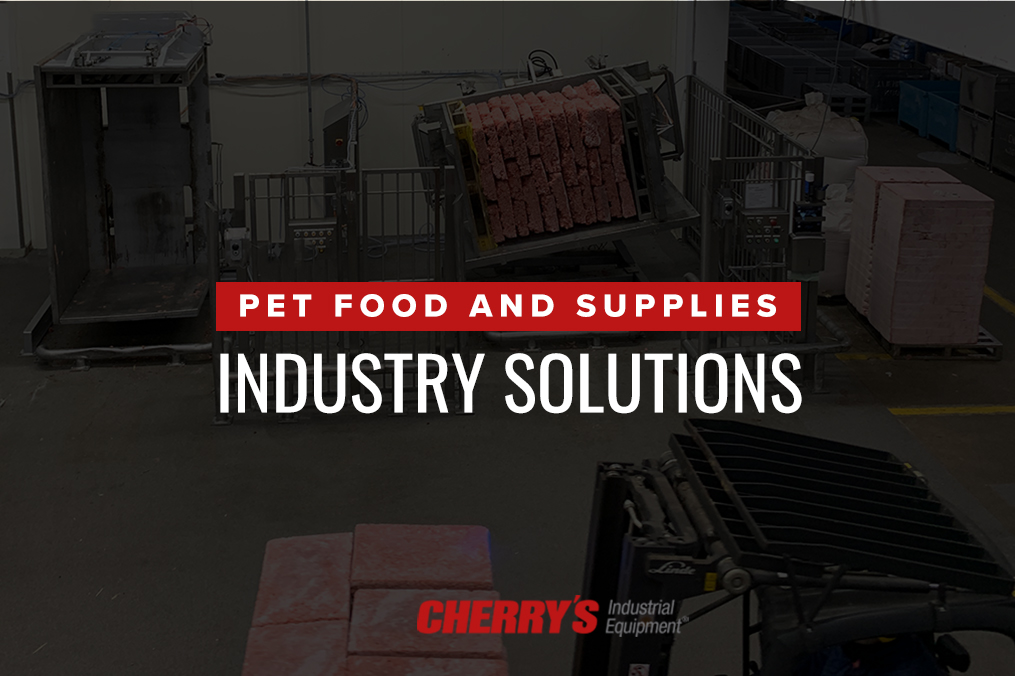
The pet food and supplies industry faces numerous hurdles today to keep its products safe and sanitary while remaining productive. Warehouses play an integral part of the supply chain for this sector. Challenges facing the pet food and supplies industry also impact storage and distribution facilities. To overcome some of the industry’s obstacles, the sector needs productive warehouses that can meet rising demand and more.
Jump to sections:
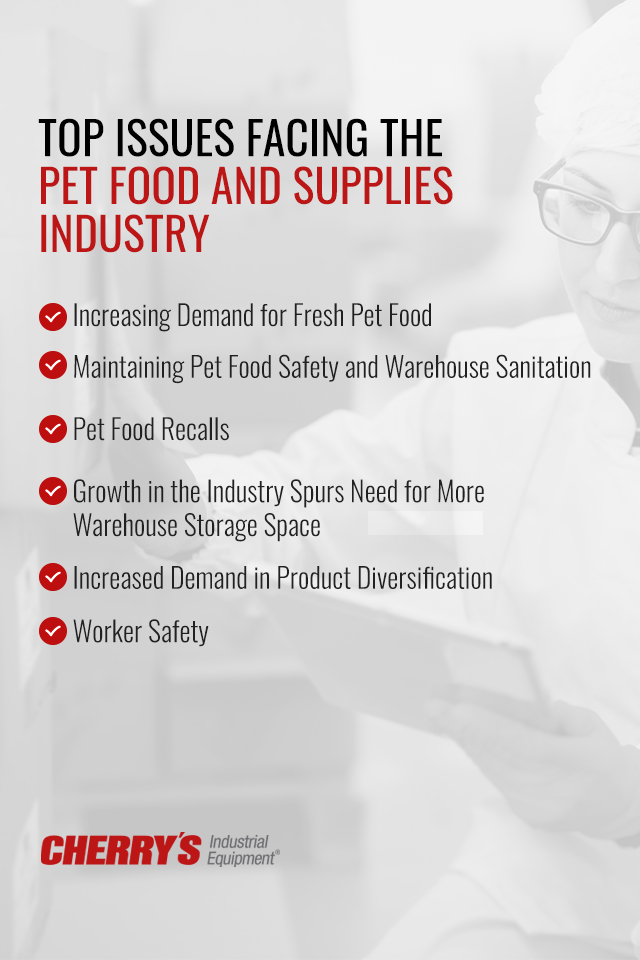
Top Issues Facing the Pet Food and Supplies Industry
The pet food and supplies industry faces an evolving economic landscape as the types of retailers, consumer demand, variety of products and more change. These shifts in the sector listed below prompt the need for changes throughout the supply chain, including in warehouses. To meet the new demands, all portions of the industry must change tactics to improve productivity and efficiency.
1. Increasing Demand for Fresh Pet Food
Fresh and frozen pet foods are increasingly popular among consumers. However, storage facilities cannot keep these products in the same facilities as they keep canned or dry pet food. Fresh and frozen pet food need carefully controlled temperatures and sanitation conditions to avoid contaminating the products. Facilities that store and distribute these products must prepare for new sections of warehouses that can hold temperature-controlled products at refrigerated or frozen temperatures reliably.
2. Maintaining Pet Food Safety and Warehouse Sanitation
Sanitation and cleanliness of facilities that store products for pets remain paramount. Regardless of the types of products in a facility, if pet foods or treats are at the facility, the site must meet strict regulations for cleanliness. In fact, facilities that handle pet food must register with the Food and Drug Administration (FDA) and face the potential for warehouse inspections 24 hours a day.
The Food Safety Modernization Act (FSMA) requires all facilities that handle food products, for people or pets, to have a food safety plan in writing and available on-site. This plan must include an analysis of any food safety hazards and preventive controls that include sanitation and processes for keeping food safe.
Employees in any food handling facility also need training under the FSMA to correctly move the products and keep them free from chemical or biological contamination, pests and improper storage conditions. Despite being in place since 2011, the FSMA still needs addressing to warehouse managers, especially as the pet supplies industry expands into new spaces that may have never handled pet food in the past.
Additionally, sanitation requirements for pet food processing facilities and warehouses brought by the 2020 pandemic will likely remain in place. In fact, some facilities have increased the frequency that they sanitize their facilities from once to twice a day. The need for extra cleaning and sanitation requires extra time and effort from workers that present a challenge for facilities that have newly expanded or grown.
3. Pet Food Recalls
By the laws of probability, with more products sold, more pet food recalls will happen. All facilities in the pet food supply chain need to become proactive to deal with recalls instead of reactive. Preparing for a pet food recall can make the process smoother in getting products off shelves and identifying the cause of the issue faster. In fact, the food safety plans required by the FSMA should include recall preparations.
Manufacturers need to have close communications with every other facility in the supply chain. If a recall occurs, sending and receiving information quickly will help mitigate the severity of the incident.
Producers also need to identify common causes of recalls and do everything possible to prevent them or internally monitor for them to enact voluntary recalls. For instance, foreign matter in pet food is the most common reason behind recalls. Other reasons include salmonella, listeria, excessive vitamins, mislabeled products or hormones.
Tracking information on products by using specific codes can help distributors, retailers, consumers and warehouse managers identify recalled products and remove them from shelves quickly. Some manufacturers may need to consider how to label their products in a manner that gets information out in an easy-to-read format without sacrificing time. For smaller manufacturers, this labeling may present a greater challenge than for larger producers.
4. Growth in the Industry Spurs Need for More Warehouse Storage Space
The pet food and supplies industry has grown dramatically from 2019 and through 2020. In 2020, sales in the industry passed $100 billion for the first time in history. The rising sales also correlate to an increase in demand for pet foods and supplies. The higher demand means manufacturers have had to step up production. However, all portions of the supply chain have not grown at the same rate.
Manufacturers need more storage space for the products they make. Existing warehouses will need to make better use of the space they have to hold more goods. With growth for the industry predicted at 5.8% for 2021, much higher than typical expansion rates of 3% to 4%, the need for more optimized use of warehouse space will not abate.
5. Increased Demand in Product Diversification
Another growing concern in the pet food and supplies industry is the rise in private labels and specialty products. Many stores have their own brands of pet food and products and smaller, independent producers also manufacture their own. Warehouses that once had to allocate space for a handful of different brands and products must now find room for a more diverse variety of pet products.
Because not all facilities store solely pet products, those that have a greater variety of goods may need to allocate more space for pet food and supplies than they used in the past. For example, a company with a private label may have both human and pet food under its store brand. With the increased popularity of pet food, the facility may need to use higher racking to accommodate more levels of pet food storage.
6. Worker Safety
Worker safety is essential for all industries. In growing sectors, the expectations of workers will also increase, putting greater demands on them that could compromise their safety. To avoid worker burnout throughout the pet products supply chain, facilities need to consider labor-saving devices and finding ways to help employees work smarter and not harder. Solutions may include options to reduce workers bending at the waist to access pallets or devices to reduce the need for unstacking and restacking products from pallets.
Solutions to These Problems
The pet food and supplies industry will likely not slow anytime soon. To keep up with higher demand and more products, warehouses need to make some changes to become more productive. Changes may include taking measures to meet peak demand, boosting efficiency and finding solutions to fit the needs of pet food requiring cold storage.

How to Meet Periods of High Demand in the Pet Food and Supplies Industry
Meeting higher sales requires preparing a warehouse for the steadily growing demand predicted in the industry. Facilities must have extremely efficient layouts. Some sites may improve operations with automation for pulling or storing stock. Other sites may need more efficient manual equipment to help workers do their jobs better and faster. For example, lift tables bring loads to safer working heights to protect employees from sustaining back injuries while handling pallets and palletizing cases.
Better organization of a warehouse may mean keeping track of high-demand products and stocking those closer to the loading docks than lower-demanded products. By reducing the time needed for workers to retrieve the most sold products, the facility wastes less time and fills orders faster.
How to Improve Pet Food Warehouse Efficiency
Improving warehouse efficiency starts with having a well-planned layout. Workers should never get lost when pulling products from racking. Nor should they have to waste steps filling orders. Planning orders based on the warehouse layout and sending that information to the worker through a tablet can reduce worker effort as they get pet products from the shelves and minimize time to do the task.
Reduction of contaminates and elimination of wood pallets entering the production facility
Raw materials and ingredients can enter directly into production facility or through an outside warehouse. To achieve the highest level of foods safety it is critical to control contaminates including bacteria, dirt, debris or splinters that may be present on inbound wood pallets. Stainless steel pallet inverters transfer frozen blocks onto clean, reusable plastic, aluminum or stainless steel pallets. Sanitizing the pallets used in pet food production is vital to keeping in line with a food safety plan. Plastic pallets, aluminum pallets and stainless steel pallets can go through washers and dryers to clean and sanitize their surfaces, preventing contamination of food products stored on top of them.
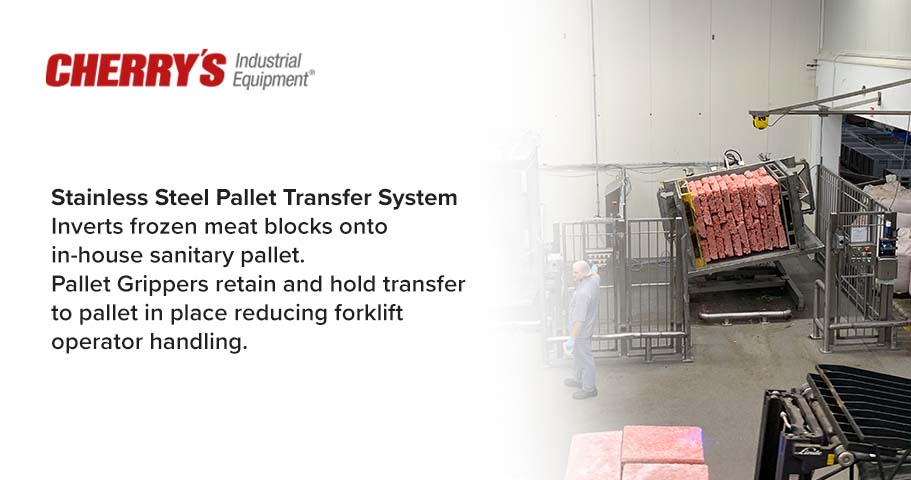
Storage and Shipping Solutions for Pet Food Warehouse Diversification
As pet food facilities need to diversify their warehousing options, they will also need to increase cold storage space. Warehouses that do not currently have cold storage areas may need to convert a portion of the warehouse space for refrigerated or frozen storage. The converted space must have measures to keep the temperature at a constant chill level, even with the high speed doors opened for removing stock.
For freezer or refrigerator storage, spacers placed between layers ensure adequate temperature control of all products on the pallet. However, when moving these goods out of cold storage, workers need to remove the spacers. Pallet and spacer removal systems facilitate this task. Pallet removers also make it easier to shift products from sanitized storage pallets to more durable shipping pallets.
Pet Food Processing Warehouse Layout for Optimized Productivity
The layout of the warehouse plays a major role in its productivity. For instance, a supplies processing warehouse layout must optimize the ability of workers to reach for needed products and quickly replace stock.
A well-organized storage space should also have the equipment to help save labor and improve safety. This equipment needs to have placement in locations around the warehouse/plant where it is most used. For instance, pallet washers should be located in the facility near processing or where the ingredients are stored and used. The pet food supplies industry equipment layout is just as important as the arrangement of storage shelves and racking in the warehouse.

Equipment Needed for Pet Food and Supplies Industry Production and Warehousing
Solutions to many of the industry’s challenges come from improving warehouse layout for pet food manufacturers and using equipment to make the space more productive. Equipment to help improve productivity, reduce labor and keep pet food storage surfaces sanitary are critical components for any pet supply storage facility.
Equipment to Improve Productivity in Pet Foods and Supplies Warehouse Facilities
Productivity in a warehouse for supplies manufacturers should never compromise cleanliness and sanitation. For example, transferring goods to plastic pallets that workers can sanitize may require extra time, but it keeps goods clean. To make this chore faster, pallet inverters can successfully transfer loads to sanitized plastic pallets without upsetting the contents. These inverters save the labor-intensive chore of restacking pallets to move their contents elsewhere.
Labor Saving Equipment for Pet Food and Supplies Warehouses
Making a warehouse more efficient means reducing labor where possible. Working smarter rather than harder will help employees avoid injuries and make their jobs easier to perform. Labor-saving equipment for pet food warehouses includes stretch wrappers that can cover pallets faster and tighter than an individual can by hand.
For instance, a human can only pre-stretch wrap 10%. But a stretch wrapper can pre-stretch the wrap up to 200%. Therefore, products don’t sustain damage and workers save time in wrapping pallets. Plus, the pallets have a tighter wrapping, which lowers the chances of products falling off and costing the facility damaged goods.
Sanitary Equipment for Pet Food and Supplies Industry Warehouses
Keeping pallets and surfaces clean is essential for maintaining the safety of pet food warehouses. Sanitation equipment includes pallet washers and dryers and pressure washers. Pallet washers and dryers ensure the cleanliness of plastic pallets between uses. Facilities that have cold storage and use spacers between layers on pallets also need to wash and sanitize these items. Pallet dryers pair well with washers to reduce the time workers must spend on cleaning and drying equipment to prepare pallets, spacers and more for use.
Pressure washers remove debris and dirt from floors that could attract pests and compromise cleanliness. They can also wash off pallets, shelving and equipment for multiple uses from the investment in this type of cleaning equipment. Portable pressure washers conveniently go wherever workers need them in a warehouse.
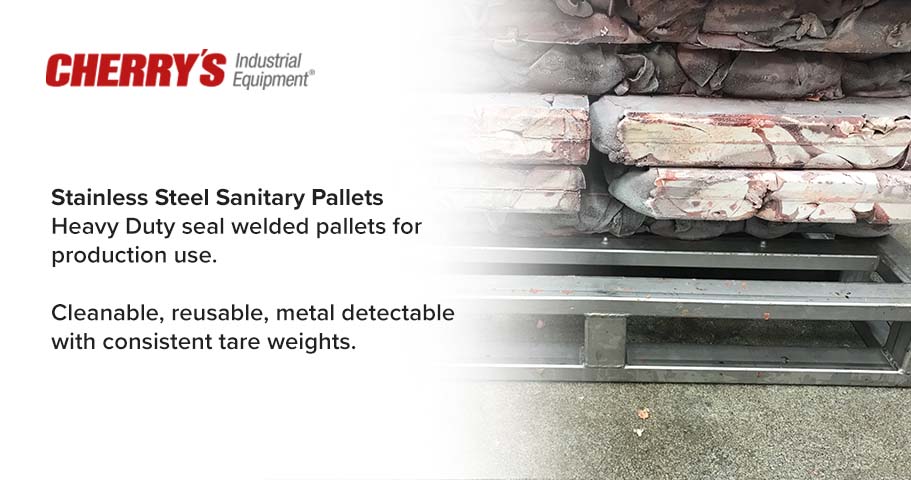
Pet Food Manufacturer Success Story
Saturn Pet Care is one of the largest pet food manufacturers in Europe, processing quality pet food in facilities in Germany and the Netherlands. Headquartered in Germany, Saturn Pet Care recently opened its first US-based manufacturing facility in Terre Haute, Indiana. In fact, 10 months prior to breaking ground in the U.S. they reached out to Cherry’s Industrial looking for help in one of their manufacturing processes. Inbound shipments of frozen blocks of raw ingredients need to be transferred from the wood shipping pallet to a hygienic stainless-steel pallet for use throughout the plant. The pallet transfers must be done in a washdown area which requires daily cleaning and sanitation. In addition, the process needs to address employee productivity, ergonomics, and employee safety which is of critical importance.
After extensive engineering communications and discovery meetings, our product specialist recommended a solution that addressed all concerns. Cherry’s Industrial would build a custom Stainless Steel Pallet Inverter with washdown-rated components that could be cleaned and sanitized. Stainless steel mesh guarding and IP67 rated light curtains would be included to protect the operating areas as well as any employees who should come too close to the machinery while in use. Additionally, Cherry’s fabricated heavy-duty stainless-steel pallets are designed to work with the Pallet Inverters pallet gripping system. The use of grippers to secure pallets made the process easier to transfer loads while at the same time reducing unnecessary pallet handling for the forklift drivers. Other process improvements include the elimination of splinters, nails, contaminants, debris, and pathogens from entering the production areas.
Contact Cherry’s Industrial Equipment for Equipment Solutions for the Pet Food and Supplies Industry
For more than 35 years, Cherry’s Industrial Equipment has helped warehouse managers improve operations, ensure safety and organize storage. Learn more about our pet food supplies industry solutions. For more information or a quote, contact us online or call 800-350-0011 today.
